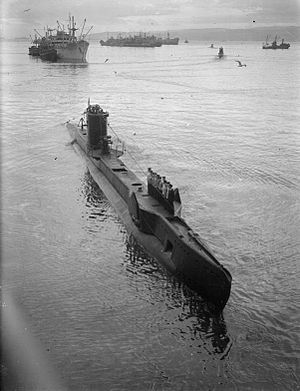British U class submarine

The U-class submarine HMS Ultimatum setting off from Holy Loch in August 1943
|
|
| Class overview | |
|---|---|
| Name: | U class |
| Operators: | |
| Preceded by: | T class |
| Succeeded by: | P611 class |
| Completed: | 49 |
| General characteristics | |
| Type: | Submarine |
| Displacement: |
|
| Length: | 191 ft (58 m) |
| Beam: | 16 ft 1 in (4.90 m) |
| Draught: | 15 ft 2 in (4.62 m) |
| Propulsion: |
|
| Speed: |
|
| Range: | 4,500 nmi (8,300 km) at 11 kn (20 km/h) surfaced |
| Complement: | 27 to 31 |
| Armament: |
|
The British U-class submarines (officially "War Emergency 1940 and 1941 programmes, short hull ") were a class of 49 small submarines built just before and during the Second World War. The class is sometimes known as the Undine class, after the first submarine built.
These small submarines, of around 630 tons, were originally intended as unarmed training vessels to replace the ageing H class, to be used as practice targets in anti-submarine training exercises.
The first three boats, HMS Undine, HMS Unity, and HMS Ursula were ordered in 1936, and during construction were modified to accommodate four internal and two external bow torpedo tubes. Apart from Undine and Unity, all boats were also equipped with a three-inch (76 mm) gun, although they lacked a hatch for the gun crew, who had instead to use the main conning tower hatch.
As war loomed, twelve more vessels were ordered, although only four had the external tubes (HMS Unique, HMS Upholder, HMS Upright and HMS Utmost). The external tubes were dropped from later vessels because they generated a large bow wave and made depth keeping more difficult at periscope depth.
They proved to be useful warships in the confined waters of the North Sea and particularly in the Mediterranean. A further 34 vessels, forming the third group, were ordered in 1940 and 1941. They were similar to the second group, but were lengthened by 5 feet (1.5 m) to provide a more streamlined shape. All but two of the 49 boats built were constructed by Vickers-Armstrong; the exceptions were HMS Umpire and HMS Una, both built at Chatham Dockyard. The submarines were powered by Paxman diesels generating 615 bhp (460 kW) and electric motors that could put out 825 shp (615 kW) giving a surface speed of 11.25 knots (21 km/h) and a submerged speed of 10 knots (19 km/h) .
...
Wikipedia
